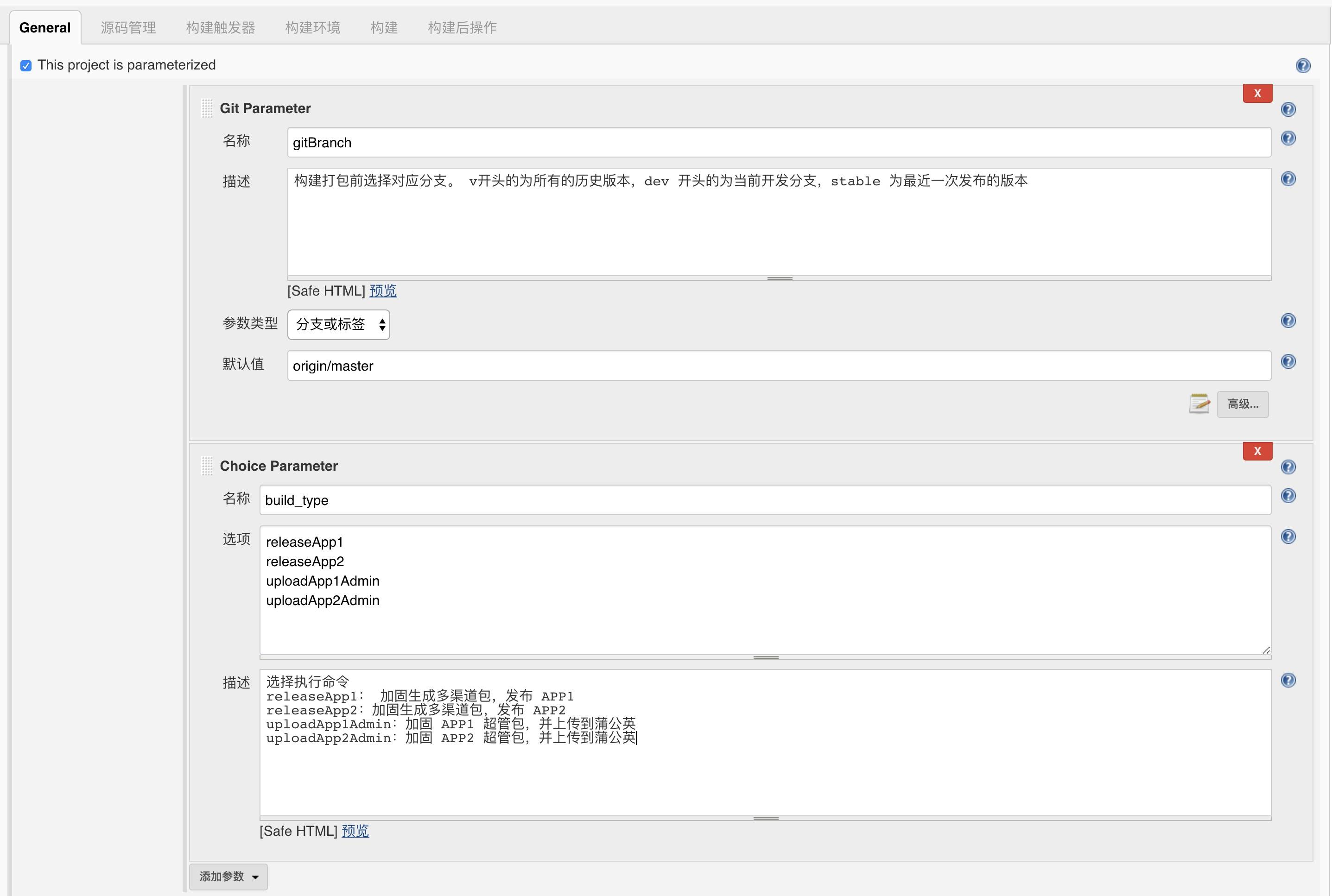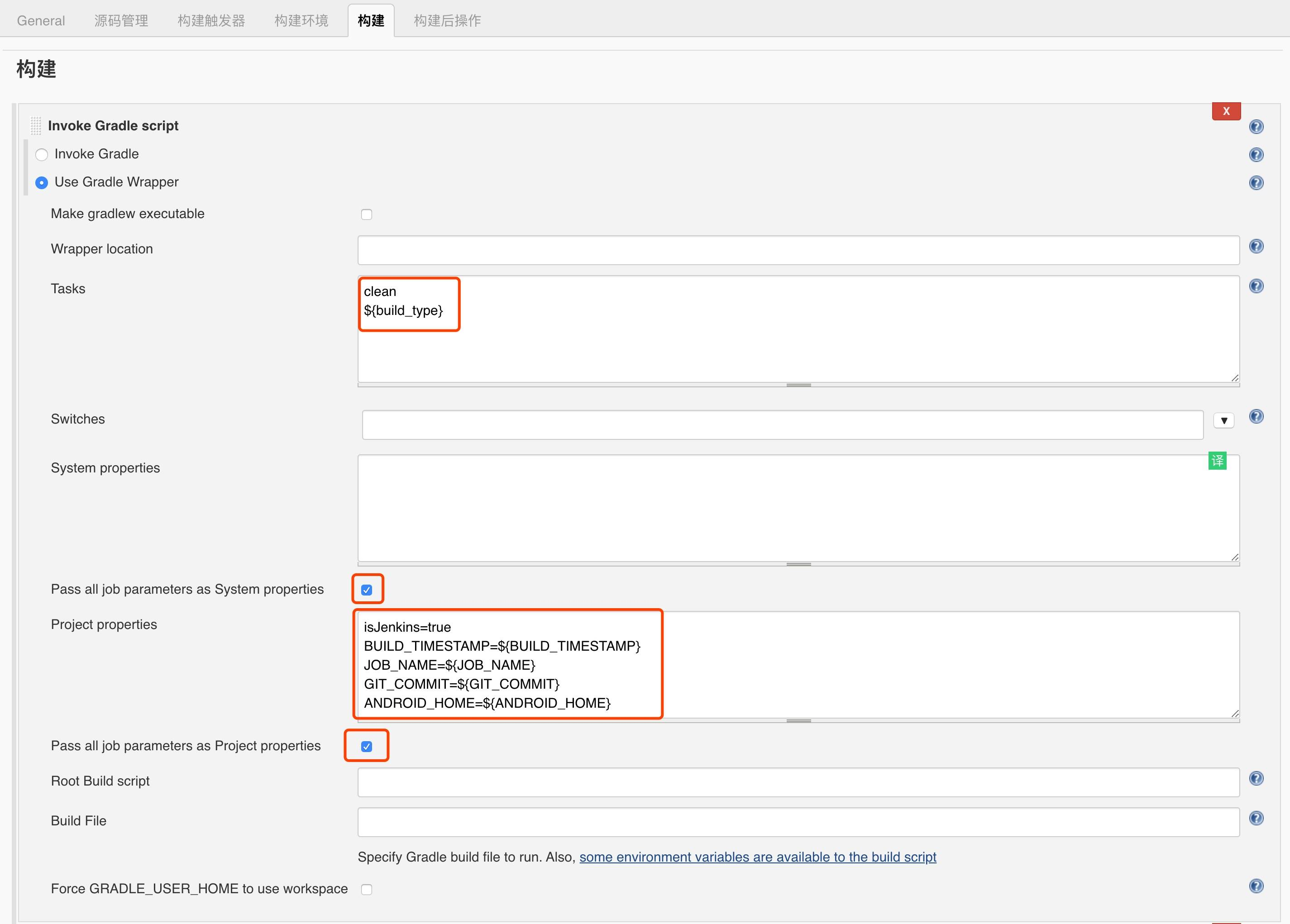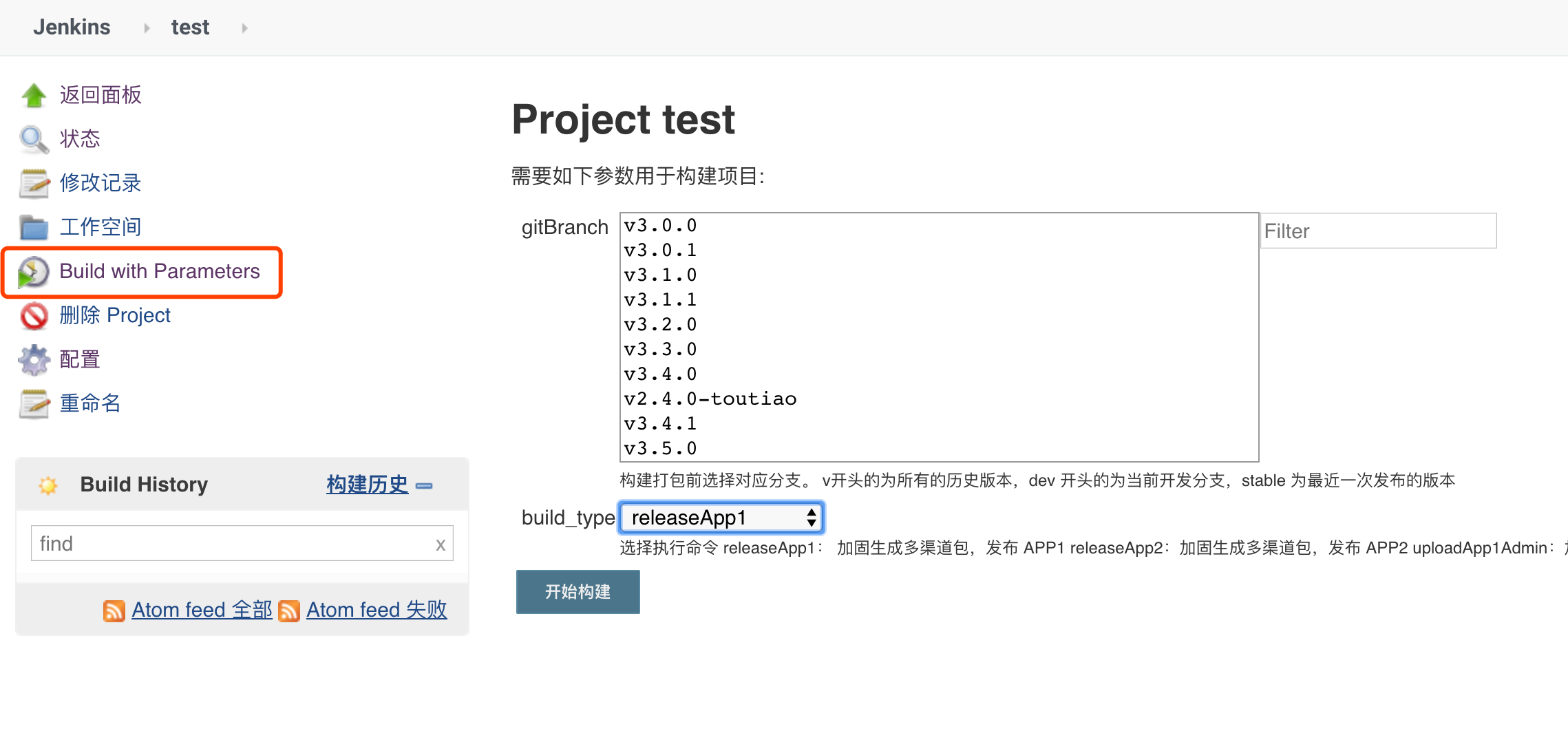前两篇文章将我们的打包加固和上传内测平台进行了自动化,节省了开发人员的时间。
但是还有一些问题并没有解决,比如我们正在吭哧吭哧的写代码,测试突然来让你给他打个包,必须要暂停当前的工作,去对应分支执行打包命令,打包期间也只能等着,不能继续写代码。
这时,Jenkins 服务器就派上用场了,我们可以将打包命令在 Jenkins 服务器进行配置,让测试人员自己去选择想要的分支版本进行打包,同时提升双方的效率。
Jenkins 相关的知识网上有很多文章,请大家自行搜索了解,本文只讲解在 Jenkins 上配置以下几点内容:
- 使用梆梆加固命令行加固
- 对加固后的包进行签名
- 使用 VasDolly 进行快速多渠道打包
- 上传安装包到蒲公英
配置 Gradle 脚本
由于将 360 加固替换为梆梆加固,而梆梆加固的命令行工具不支持自动签名和本地多渠道包生成,所以增加了重新签名和 VasDolly 多渠道打包的命令。
加固脚本
完整的 config.gradle 配置:
ext {
curGitCommit = rootProject.properties['GIT_COMMIT'] == null ? getGitCommit() : rootProject.properties['GIT_COMMIT']
curTime = rootProject.properties["BUILD_TIMESTAMP"] == null ? getCurTime() : rootProject.properties["BUILD_TIMESTAMP"]
backupPath = "../buildBackup/"
if (rootProject.properties["isJenkins"].toBoolean()) {
androidHome = rootProject.properties['ANDROID_HOME']
} else {
Properties properties = new Properties()
properties.load(project.rootProject.file('local.properties').newDataInputStream())
androidHome = properties.getProperty('sdk.dir')
}
//签名文件配置
signing = [keyAlias : 'xxxxx',
keyPassword : 'xxxxx',
storeFile : '../sign.keystore',
storePassword: 'xxxxxx']
//蒲公英配置
pgy = [apiKey : "xxxx",
uploadUrl: "https://www.pgyer.com/apiv2/app/upload"]
//加固配置
jiagu = [
app1Online : "${backupPath}${curGitCommit}/${curTime}/app1Online_jiagu/",
app1Admin : "${backupPath}${curGitCommit}/${curTime}/app1Admin_jiagu/",
app2Online : "${backupPath}${curGitCommit}/${curTime}/app2Online_jiagu/",
app2Admin : "${backupPath}${curGitCommit}/${curTime}/app2Admin_jiagu/",
channelConfigPath: '../jiagu/Channel.txt',
VasDollyJar : "../jiagu/VasDolly.jar",
banbanJar : "../jiagu/secapi.jar",
banbanName : rootProject.properties['banbanName'] == null ? "banbanName" : rootProject.properties['banbanName'],
banbanApiKey : rootProject.properties['banbanApiKey'] == null ? "banbanApiKey" : rootProject.properties['banbanApiKey'],
banbanSecretKey : rootProject.properties['banbanSecretKey'] == null ? "banbanSecretKey" : rootProject.properties['banbanSecretKey'],
banbanIp : rootProject.properties['banbanIp'] == null ? "banbanIp" : rootProject.properties['banbanIp'],
]
android = [compileSdkVersion: 28,
buildToolsVersion: "29.0.3",
minSdkVersion : 19,
targetSdkVersion : 28]
apksignerDir = "${androidHome}/build-tools/${android['buildToolsVersion']}/"
//版本号管理
APP1_VERSION_NAME = "2.0.2"
APP1_TEST_NUM = "0001"
APP2_VERSION_NAME = "1.0.5"
APP2_TEST_NUM = "0005"
dependencies = [
"androidx-appcompat" : "androidx.appcompat:appcompat:1.1.0",
"androidx-constraintlayout": "androidx.constraintlayout:constraintlayout:1.1.3",
"VasDolly-helper" : "com.leon.channel:helper:2.0.3",
]
}
static def getCurTime() {
return new Date().format("yyyy-MM-dd_HH-mm-ss")
}
static def getGitCommit() {
def exceptionStr = "git rev-parse HEAD 执行失败"
try {
def cmd = 'git rev-parse HEAD'
def gitCommit = cmd.execute().text.trim()
if (gitCommit.isEmpty()) {
throw new GradleException(exceptionStr)
}
return gitCommit
} catch (Exception e) {
throw new GradleException(exceptionStr, e)
}
}
在jiagu.gradle中实现加固签名和多渠道包逻辑:
import org.apache.tools.ant.taskdefs.condition.Os
/**
* 加固
* @param config 配置加固策略
* @param apkPath 要加固的文件路径
* @param outputPath 输出路径
* @param channelName 渠道名,为 Null 时读取 rootProject.ext.jiagu["channelConfigPath"] 多渠道配置文件
*/
def jiaGu(String config, String apkPath, String outputPath, String channelName) {
println("开始加固 \nconfig:$config \napkPath:$apkPath \noutputPath:$outputPath \nchannelName:$channelName")
exec {
executable = 'java'
args = ['-jar', rootProject.ext.jiagu["banbanJar"],
'-i', rootProject.ext.jiagu["banbanIp"],
'-u', rootProject.ext.jiagu["banbanName"],
'-a', rootProject.ext.jiagu["banbanApiKey"],
'-c', rootProject.ext.jiagu["banbanSecretKey"],
'-f', '0',
'-t', config,
'-p', apkPath,
'-d', outputPath,
]
}
println "加固的文件路径:${apkPath}"
println "加固后的文件路径:${outputPath}"
def signApkPath = apkSigner(outputPath)
generatingMultipleChannels(signApkPath, outputPath, channelName)
//在 Jenkins 上运行时,将构建产物备份到硬盘根目录,
if (isJenkins.toBoolean()) {
String sourceDir = file(outputPath).parentFile.absolutePath
String destinationDir = "/Users/buildBackup/${rootProject.properties["JOB_NAME"]}/${rootProject.ext.curGitCommit}/${rootProject.ext.curTime}/"
new groovy.util.AntBuilder().copy(todir: destinationDir) {
fileset(dir: sourceDir)
}
println "将构建产物备份到:${destinationDir}"
}
}
def apkSigner(String apkDir) {
def apkFile = getApkFile(apkDir)
if (apkFile == null || !apkFile.exists()) {
throw GradleException("加固后的 apk 文件不存在")
}
def signDir = new File(apkDir, 'sign')
if (!signDir.exists()) {
signDir.mkdirs()
}
def outputApkPath = new File(signDir, apkFile.name)
def storeFile = rootProject.ext.signing["storeFile"]
def storeFilePath = file(storeFile).absolutePath
//兼容 Windows、Mac、Linux 系统
def execuTable = Os.isFamily(Os.FAMILY_WINDOWS) ? 'cmd' : 'sh'
def apksigner = Os.isFamily(Os.FAMILY_WINDOWS) ? 'apksigner.bat' : './apksigner'
println("对加固包进行签名")
def parameter = [apksigner, 'sign',
'--ks', storeFilePath,
'--ks-key-alias', rootProject.ext.signing["keyAlias"],
'--ks-pass', "pass:${rootProject.ext.signing["storePassword"]}",
'--key-pass', "pass:${rootProject.ext.signing["keyPassword"]}",
'--out', outputApkPath, apkFile.absolutePath]
if (Os.isFamily(Os.FAMILY_WINDOWS)) {
parameter.add(0, '/c')
}
exec {
workingDir = rootProject.ext.apksignerDir
executable = execuTable
args = parameter
}
println "apk 签名成功:" + outputApkPath
return outputApkPath
}
/**
* 生成多渠道包
* @param signApkPath 基准包
* @param outputDir 输出目录
* @param channelName 渠道名,为 Null 时读取 rootProject.ext.jiagu["channelConfigPath"] 多渠道配置文件
*/
private void generatingMultipleChannels(signApkPath, outputDir, channelName) {
def channelDir = new File(outputDir, 'channels')
if (!channelDir.exists()) {
channelDir.mkdirs()
}
println("生成多渠道包")
def channel = channelName == null ? rootProject.ext.jiagu["channelConfigPath"] : channelName
exec {
executable = 'java'
args = ['-jar', rootProject.ext.jiagu["VasDollyJar"],
'put', '-c', channel,
signApkPath, channelDir.absolutePath
]
}
println("生成多渠道包完毕")
}
def getApkPath(String flavor) {
if ("app1Online" == flavor) {
return "${projectDir.absolutePath}/build/outputs/apk/production/release/${getApkName(rootProject.ext.android["versionName"])}"
} else {
return "${projectDir.absolutePath}/build/outputs/apk/${flavor}/release/${getApkName(getTestVersionName(flavor))}"
}
}
private def getApkFile(String fileDir) {
def dir = file(fileDir)
if (!dir.exists()) {
println "dir not exists:" + dir.path
return null
}
File[] files = dir.listFiles(new FileFilter() {
@Override
boolean accept(File file) {
return file.isFile() && file.name.endsWith(".apk")
}
})
if (files == null || files.size() == 0) {
println "files == null || files.size() == 0"
return null
}
return files[0]
}
private static void checkOutputDir(File apkOutputFile) {
if (apkOutputFile.exists()) {
File[] files = apkOutputFile.listFiles()
if (files != null) {
for (File file : files) {
file.delete()
}
}
} else {
apkOutputFile.mkdirs()
}
}
/**
* App1
* 根据多渠道文件进行加固
* 执行命令:./gradlew releaseApp1
*/
task releaseApp1(dependsOn: ['assembleApp1OnlineRelease']) {
group = "publish"
doLast {
def apkOutputFile = file(rootProject.ext.jiagu["app1OnlineOutputPath"])
checkOutPutDir(apkOutputFile)
def apkFile = file(getApkPath("App1Online"))
if (!apkFile.exists()) {
println("apk file is not exists:" + apkFile.absolutePath)
return
}
jiaGu("1", apkFile.absolutePath, apkOutputFile.absolutePath, null)
}
}
我们只需要在命令行执行 ./gradlew releaseApp1 就会执行编译—>加固—>签名—>生成多渠道包
上传蒲公英的代码和前文一样,只需要改动一下 apk 路径,取生成的渠道包进行上传。
Jenkins 配置
首先我们创建好任务,配置 task 命令参数:

再配置 Gradle 插件执行上面选择的命令,并配置 Project properties:

如果执行上传蒲公英的任务,我们希望直接显示蒲公英的二维码,增加如下Set build description配置:

我们保存配置,执行任务:


总结
全文没有做太多讲解,直接上代码上配置图片,简单粗暴,如果 Gradle 部分有疑惑的建议看看前面几篇文章。
对于 Jenkins 的配置本文只是一笔带过,相信大家简单了解一下相关的概念和原理就能快速上手,基本流程跑通以后可以举一反三实现更多功能。
最后上 demo 地址:github.com/imliujun/Gr…
相关阅读
欢迎关注微信公众号:**大脑好饿**,更多干货等你来尝